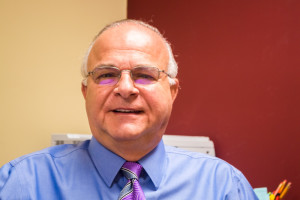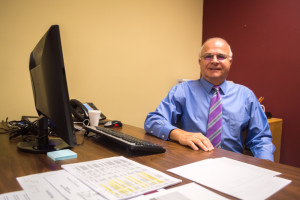Tags
Related Posts
Share This
Raffles Transition

Charles Restivo looks forward to aiding in the transition of ownership and seeing that it goes as smoothly as possible. Photo by Jennifer Rapinchuk
Santa Fe University of Art and Design has seen its fair share of changes over the years. The school, which began as St. Michael’s College in 1859, then changed its name to the College of Santa Fe in 1966, was taken over and renamed again by Laureate International Universities in 2009. Then, during the summer of 2016, Raffles Education Corporation announced its plans to purchase the school.
With so much volatility and fear of financial solvency throughout the years, the future of the college has come into question. Film legend and SFUAD donor Robert Redford wrote a letter published in the Santa Fe New Mexican expressing his concern. Student Facebook groups lit up with speculation about the reasons for the shift in ownership. With an impending sale, the school is hesitant to make any permanent changes until they’re sure of the direction that Raffles wants to take.
Enter Charles Restivo, a Raffles consultant charged with leading the transition from one company to the next. Restivo (who, for lack of an official title, identifies himself as a transition manager) currently makes his home in SFUAD’s Welcome Center. He says the challenge in this transition is making the school a “self-sufficient, autonomous institution.”
Laureate International Universities has its headquarters in Baltimore, Maryland. Any student who has ever had to take their financial aid concerns to a higher authority than Mouton Hall, has probably spoken with someone in the Baltimore office.
“That’s one example that probably touches students the most,” Restivo says.
Singapore-based Raffles owns 26 art and design colleges in 12 countries across the world, but SFUAD is its first U.S.-based institution. Unlike Laureate, each of Raffles’ schools operates autonomously, so any services currently offered by Laureate’s Baltimore branch will “have to be migrated over to this institution as an autonomous entity, and it has to happen over time,” Restivo says. “It doesn’t happen immediately. It’s not like flipping a switch to have a change of ownership. It will probably extend a fair amount of time into 2017.”
Restivo says students need not worry about a disruption in their education, as occurred when the school transitioned from the College of Santa Fe to Santa Fe University of Art and Design.
“The last time it went through a transformation like this, there was a refocus in academic programs and the direction of the institution,” Restivo says. “Raffles is a company that operates art and design colleges exclusively. There are absolutely no plans at this point to disrupt anything educationally. But there may be a time in the future where we would introduce new programs that are in line with the mission of the institution that perhaps supplement and complement the existing offerings.”
Will Winkowski assists Restivo as part of the transition team, traveling back and forth from his home in Indiana to the SFUAD campus. He plans to visit the campus for several weeks in November, tackling the more “hands on details” of the transition. That includes everything from examining how enrollment forms are used, to making sure employees get paid to improving dorm facilities.
“Charles is involved with the more high level matters and strategy, whereas I’m interacting more closely with all the steps of the transition,” Winkowski says. “Basically, whatever Charles says to do, I do it.”
If all goes as planned, completion of the Raffles sale will take place in December 2016, though that is partially dependent on outside entities.

Charles Restivo claims that, unlike Laureate, whose main offices are located in Baltimore, Raffles intends to support the university directly from its campus. Photo by Jennifer Rapinchuk
“As you know, there’s approval processes that the institution Raffles has no control over, like with the Higher Learning Commission,” Restivo says. “I’m basing that date off of what had been previously established, assuming the current timeline for HLC approval and we think that’s going well, but we’re not in control of that entirely.”
The Higher Learning Commission, which accredits SFUAD, visited the campus in September, meeting with Laureate and Raffles officials to ensure the school it reaccredited last year will continue to be the same school when Raffles takes over at the end of the year.
“Any time there’s a change of ownership of any institution, they want to make sure that the new owners are going to operate the institution in accordance with HLC criteria and requirements,” Restivo says. “You can’t just transfer an accreditation without affirmation that new ownership is going to provide the same resources and support.”
Restivo is a veteran of higher education, having worked exclusively with art and design schools for 25 years. Most recently, he was the president of the Art Institutes for 13 years. He began his career working for DeVry University, but migrated from the technology-driven school to art and design institutions as he transitioned into higher levels of management.
“I’ve gravitated towards art and design colleges from an executive leadership position,” Restivo says. “I love the passion of students. I love the passion of faculty. It’s certainly much more interesting to me than the generic environment of business or technology. I just find this much more intriguing and exciting in terms of the people you meet, the program offerings and the faculty.”
Resitvo spends his day Skyping with Raffles COO Doris Chung Gim Lian, communicating with the other members of the transition team scattered across the country, and meeting with SFUAD department chairs to discuss concerns, expectations and needs for the school moving forward. That being said, he tries to get out of his office as much as possible.
“I want to be out on campus, looking at the facilities, seeing what students do every day. I’m going through the academic facilities as well, getting a better understanding of the programs and most importantly, student needs and program needs,” Restivo says. “That really is the highlight of my day, getting out and meeting people, getting to know people better, and being very forthright in the conversation.”
Restivo hopes to hold forums in the future for students who have questions about the transition. In the meantime, Restivo encourages students to visit him in his office in the Welcome Center.
“I like to talk to students and get their feedback every opportunity that I can,” he says. “Stop me and talk to me. I enjoy doing that more than anything else.”






 Jackalope Magazine is the student magazine of Santa Fe University of Art and Design. Building on the interdisciplinary nature of our education, we aim to showcase the talent of our university and character of our city.
Jackalope Magazine is the student magazine of Santa Fe University of Art and Design. Building on the interdisciplinary nature of our education, we aim to showcase the talent of our university and character of our city.
this provides more information about the transition than I’ve received from any other source. thank you so much.